Scientific papers 2024 - Part B



Authors:
Maher Khalife, Michele Salvagno, Maurice Sosnowski, and
Costantino Balestra
This study assesses the effectiveness of a normobaric
oxygen paradox (NOP) protocol in stimulating
erythropoiesis in cancer patients undergoing abdominal
surgeries to determine whether NOP can increase
reticulocyte counts, indicating enhanced erythropoiesis in
this patient population. It details the methodology used,
results, and conclusions, highlighting the potential of NOP
therapy while acknowledging the need for further
research.
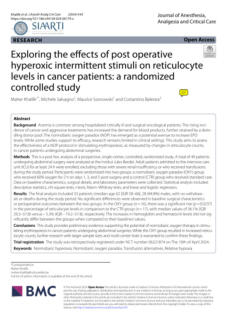

Authors:
Irina Popova, Evgeniya Dvurekova, Aleksandr Sysoev
This study investigates the body composition and
microcirculation characteristics of qualified divers using
different types of gymnastic equipment to understand
how these factors can improve the effectiveness of
training for divers. It provides specific results regarding
changes in body composition and microcirculatory
function among divers, and highlights the importance of
these findings for enhancing training effectiveness.
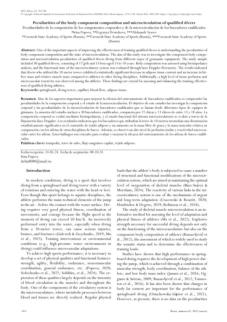

Authors:
Thomas Kjeld, Anders Brenøe Isbrand, Henrik Christian
Arendrup, Jens Højberg, Jacob Bejder, Thomas O. Krag,
John Vissing, Lars Poulsen Tolbod, Johannes Hendrik
Harms, Lars Christian Gormsen, Dan Fuglø, and Egon
Godthaab Hansen
This study investigates the physiological adaptations of
elite breath-hold divers (BHD) during apnea, comparing
them to diving mammals like Bottlenose Dolphins to
explore whether BHD have similar oxygen-conserving
mechanisms, focusing on pulmonary blood volume (PBV)
and alveolar ventilation to perfusion ratio (V A /Q). It
details the methods used, the results obtained, and
highlighs the adaptations of BHD in terms of pulmonary
function and oxygen delivery.
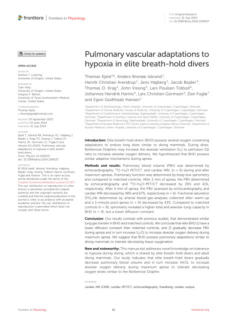

Authors:
Tatjana Baldovin, Francesco Bassan, Chiara Bertoncello,
Alessandra Buja, Silvia Cocchio, Marco Fonzo, and
Vincenzo Baldo
This paper advocates for integrating healthcare simulation
into the training of health professionals, particularly in the
field of Public Health. It highlights the benefits of
simulation in improving clinical performance, reducing
costs, and enhancing education standards. Additionally, it
proposes a pilot project to train professionals using an
interdisciplinary and innovative approach to improve
patient quality and safety further.
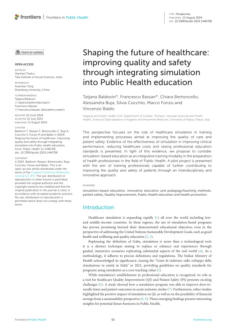

Authors:
Irina Evgenievna Popova, Aleksander Vladimirovich
Sysoev, and Viktor Leonidovich Kondakov
This paper conveys research findings on the importance of
neuromuscular development for achieving high
performance in diving. It discusses the correlation
between neuromuscular function and the composition of
muscle and adipose tissue in divers, emphasizing the need
to develop muscle mass and reduce fat to enhance nerve
impulse conductivity and muscle synchronization,
ultimately improving diving performance.
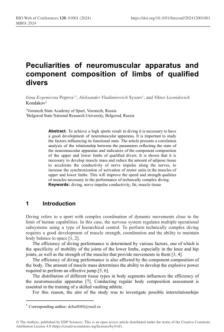

Authors:
Lucille Daubresse, Aurélie Portas, Alexandrine Bertaud,
Marion Marlinge, Sandrine Gaillard, Jean-Jacques Risso,
Céline Ramdani, Jean-Claude Rostain, Nabil Adjiriou,
Anne-Virginie Desruelle, Jean-Eric Blatteau, Régis Guieu,
and Nicolas Vallée
This study investigates the effects of CO2 exposure on the
occurrence of decompression sickness (DCS) in mice to
evaluate whether breathing CO2 prior to a dive increases
the risk of DCS and explores the potential role of body
temperature and microbiota composition in influencing
the outcomes. It details the methodology and results,
highlighting the significant increase in DCS incidence
following CO2 exposure and suggesting a link between
microbiota, thermogenesis, and susceptibility to DCS.
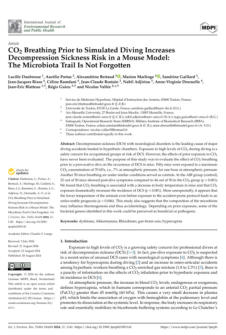

Authors:
T. A. Giacon, Simona Mrakic-Sposta, G. Bosco, A. Vezzoli,
Cinzia Dellanoce, M. Campisi, M. Narici, M. Paganini, B.
Foing, A. Kołodziejczyk, M. Martinelli, S. Pavanello
This study investigates the effects of isolation, circadian
rhythm disruption, and psychophysical stress on humans
in a simulated space environment to understand how
these factors impact stress responses, sleep quality, and
oxidative stress levels in individuals participating in an
analog astronaut mission. The text outlines the methods
used, the results obtained, and the conclusions drawn
from the experiment, highlighting the potential
implications for human performance in space missions.
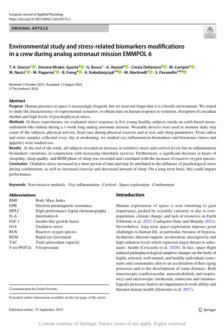

Authors:
Władysław Wolanski, Stanisław Pełka, Józef Ramisc
This document reports on the findings of a pilot program
that incorporated psychological testing into the
recruitment process for military and scuba divers,
highlighting the importance of psychological assessments
in determining the suitability of candidates for diving
training and service, suggesting that such testing should
be a standard part of the selection process, as is done in
other countries.
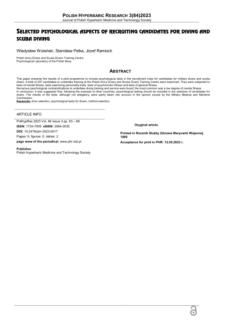

Authors:
Emmanuel Dugrenot, Anthony Guernec, Jérémy Orsat,
François Guerrero
This study focused on understanding the mechanisms of
decompression sickness (DCS) through genetic and
molecular analysis. It involves selectively bred rats with
increased resistance to DCS and uses analyses to identify
pathways related to inflammatory and immune responses,
as well as other cellular processes. It shares the research
methodology, results, and conclusions, highlighting the
discovery of similar pathways in both male and female
rats, which could contribute to a better understanding of
gene expression and phenotype differences related to
DCS.
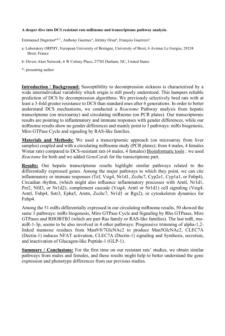

Authors:
Emmanuel Gouin, David PM Monnot, Thierry Michot,
François Guerrero, Jean-Eric Blatteau
This small presentation introduces the findings of a study
conducted on the practices and incidents related to deep
diving using helium-mixed-gas, specifically within the
technical diving community, to provide an
epidemiological overview of diving practices, risk factors,
and the occurrence and management of diving-related
incidents.
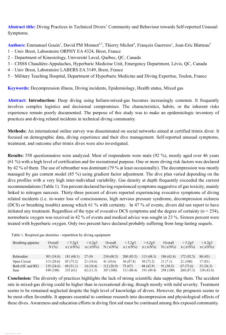

Authors:
Rhiannon J. Brenner, Kiran A. Balan, Marie P. L. Andersen,
Emmanuel Dugrenot, Xavier C. E. Vrijdag, Hanna Van
Waart & Frauke Tillmans
This paper provides a narrative review of the nutritional
recommendations for recreational scuba divers. It aims to
summarize existing guidelines, highlight the physiological
challenges divers face, and identify research gaps
regarding the relationship between nutritional intake and
the health and safety of divers. In addition, it outlines
specific dietary recommendations based on workload and
diving conditions, emphasizing the importance of
macronutrient distribution and protein intake.
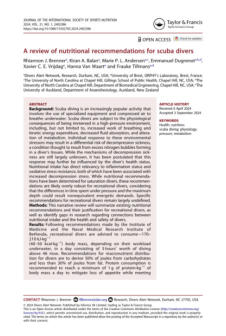

Authors: Muinat Abolore Idris, Christine Markham, Kristina
D. Mena, and William B. Perkison
This presentation describes findings on the factors
affecting heat stress among construction workers,
specifically in the context of natural gas construction sites.
It aims to identify barriers and facilitators to worker safety
and evaluate the effectiveness of a heat stress intervention
program. In addition, it provides recommendations for
improving the safety, health, and well-being of
construction workers in hot environments, emphasizing
the need for employee involvement, employer
management, accessible resources, mandatory rest breaks,
and comprehensive heat stress education.
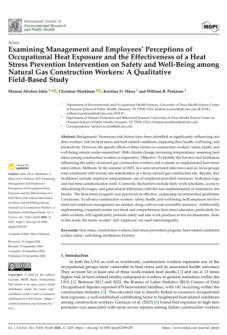

Authors:
Luigi Fattorini, Angelo Rodio, Tommaso Di Libero, Cristian
Ieno, Giovanna Tranfo, Daniela Pigini, Alessandro Pinto,
and Enrico Marchetti
This paper describes the findings of a study on the
physiological effects of SCUBA diving on heart rate (HR) at
different depths that involved recording the HR of 18
healthy subjects while diving in thermal water at a
constant temperature to understand how HR changes
during various phases of a dive and at varying depths,
highlighting the physiological adjustments and cardiac
stress associated with diving.
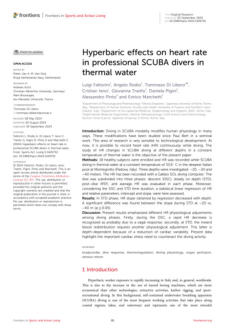

Author: Tom S. Neuman
This document explains the physiological problems
associated with decompression from elevated atmospheric
pressures, mainly focusing on the effects on divers. It
discusses two main categories of issues: mechanical
injuries due to gas expansion and the formation of gas
phases in tissues leading to decompression sickness (DCS).
It also delves into specific conditions, such as pulmonary
overinflation syndromes and arterial gas embolism (AGE),
describing their causes, symptoms, and potential
outcomes.
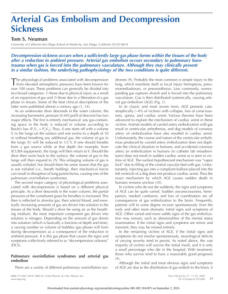

Authors: Robert A van Hulst, & Pieter-Jan AM van Ooij
This document is a retrospective study on lung function in
military divers, specifically focusing on the incidence of
lung abnormalities such as blebs and bullae and the role
of computed tomography (CT) scans in assessing fitness to
dive. It informs and advises on best practices for evaluating
divers' lung health, suggesting the use of Global Lung
Initiative reference values and recommending high-
resolution CT scans only for those with clinical indications.

Author: Neal W. Pollock
This paper aims to inform and advise divers about the
importance of thermal protection in coldwater diving
environments. It highlights the potential hazards
associated with inadequate and excessive thermal
protection, emphasizing the need for careful consideration
of safety over comfort, discussing the limitations of current
dive computers in assessing thermal status, and
suggesting that divers are responsible for managing their
thermal protection to ensure safety during dives.
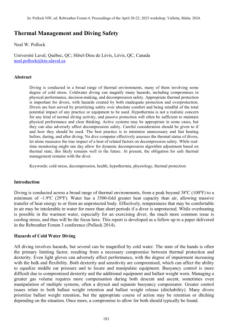

Authors:
Hadrien Pique, Sigrid Theunissen, Costantino Balestra,
Juani Valdivia, Oleg Melikho
This study investigates the prevalence of preterm birth
among elite freedivers and its potential impact on their
performance to determine whether being born
prematurely affects freediving results. It concludes that
while the proportion of preterm births is higher among
elite freedivers compared to the general population, there
is no significant difference in performance between
preterm and full-term athletes.
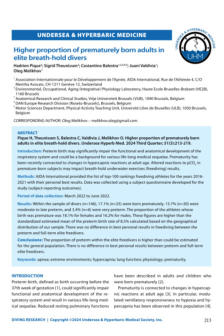

Authors: Jan Risberg, Helle Midtgaard
This paper reports and analyze an unusual incident of
decompression sickness (DCS) that occurred during a
commercial diving project. It details the circumstances of
the incident, including the number of dives, the depth and
duration of the dives, the error in the decompression
procedure, and the resulting cases of DCS. It also discusses
the implications of the error on DCS incidence rates and
provides observations on the effects of omitted
decompression time. Additionally, it includes follow-up
information on the divers involved, noting that some
reported minor symptoms of DCS after the project
concluded.
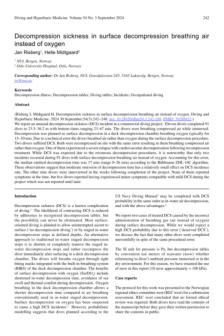

Authors:
Arnaud Druelle, Olivier Castagna, Romain Roffi, Pierre
Louge, Anthony Faivre, and Jean-Eric Blatteau
This paper describes and analyzes an unusual incident of
decompression sickness (DCS) that occurred during a
commercial diving project. It details the circumstances of
the incident, including the number of dives, the depth and
duration of the dives, the error in the decompression
procedure, and the resulting cases of DCS. It also discusses
the implications of the error on DCS incidence rates and
provides observations on the effects of omitted
decompression time. Additionally, it includes follow-up
information on the divers involved, noting that some
reported minor symptoms of DCS after the project
concluded.
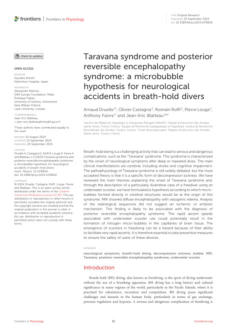
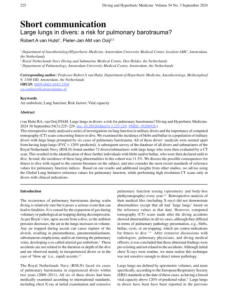

This workshop discussed potential updates and revisions
to "The Guide for the Care and Use of Laboratory
Animals". The presentation discusses the efforts made by
the Standing Committee for the Care and Use of Animals
in Research to gather input from various stakeholders
through listening sessions and a survey, culminating in a
virtual workshop. It highlights the collaborative nature of
the workshop, the diversity of participants, and the
collection of feedback and suggestions for future updates
to the Guide.
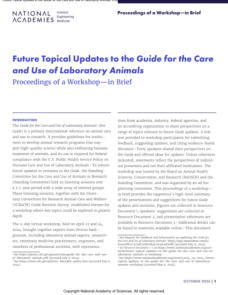

Authors: Nozomu Kageyama, and Takehito Sawamura
This study investigated the effects of hyperbaric exposure
on cognitive function in divers during saturation diving at
a depth of 45 atmosphere absolute (ATA). The study
utilized Stroop tasks to assess cognitive performance and
found that reaction times were delayed and correct rates
decreased at 45 ATA compared to 1 ATA. The study
emphasizes the importance of monitoring cognitive
function in deep sea saturation diving and suggests the
need for further research and training in this area.
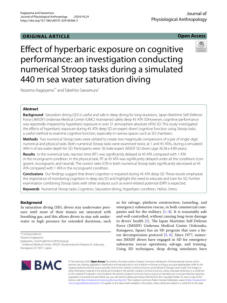

Authors: Andreas Fahlman, Warren Burggren, and
William K. Milsom
The aim of this document is to present research findings
and insights on the dive response in air-breathing
vertebrates, particularly focusing on the role of cognitive
control and conditioning in heart rate regulation during
dives to explain how these physiological responses can be
anticipatory and vary based on the type and length of the
dive, suggesting a cognitive component. It also discusses
the implications of these findings for improving diving
capacity and preventing diving-related issues, such as
decompression sickness, through mechanisms like the
selective gas exchange hypothesis..
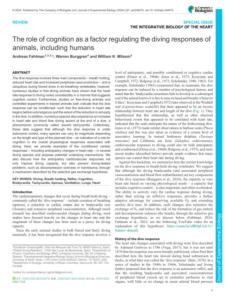

Authors: Emmanuel Dugrenot, Anthony Guernec, Jérémy
Orsat, & François Guerrero
This paper presents a study on the effects of hyperbaric
conditions on cognitive functioning, explicitly using the
critical flicker fusion frequency (CFFF) test. It highlights the
importance of considering possible side effects of
hyperbaric oxygen therapy (HBOT) on medical staff, such
as decompression sickness, and reports findings on how
oxygen breathing during decompression affects CFFF
results.
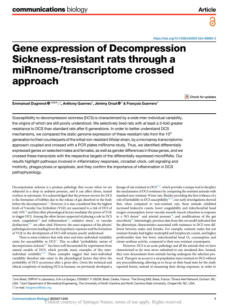

Authors: Rita I. Sharma, Natalia D. Mankowska, Anna B.
Marcinkowska, Pawel J. Winklewski, Jacek Kot
This paper presents a study on the effects of hyperbaric
conditions on cognitive functioning, explicitly using the
critical flicker fusion frequency (CFFF) test. It highlights the
importance of considering possible side effects of
hyperbaric oxygen therapy (HBOT) on medical staff, such
as decompression sickness, and reports findings on how
oxygen breathing during decompression affects CFFF
results.
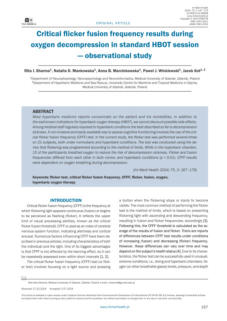

This document is the 2024 update of the Declaration of
Helsinki, developed by the World Medical Association
(WMA), for conducting safe and respectful medical
research involving human participants. It aims to
communicate the principles of the organization that
should be adhered to by all parties involved in medical
research to ensure the protection of research participants.
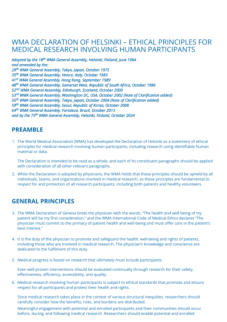

Authors:
Zuha Imtiyaz, Owen J. O'Neill, Douglas Sward, Phi- Nga
Jeannie Le, Awadhesh K. Arya, Veena M. Bhopale, Abid R.
Bhat, Stephen R. Thom
This text presents a scientific hypothesis and research
findings regarding the physiological responses of tunnel
construction workers to high-pressure exposures
compared to SCUBA divers. The study aims to investigate
the inflammatory responses and potential
pathophysiology of decompression sickness (DCS) in these
two groups, focusing on blood microparticles, interleukin
levels, plasma gelsolin, and neutrophil activation. The text
concludes with findings that suggest differences in
neutrophil activation based on the duration of pressure
exposure
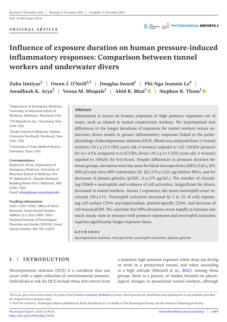



10 - Taravana syndrome and posterior reversible encephalopathy
syndrome: a microbubble hypothesis for neurological accidents
in breath-hold divers.

Authors: Arnaud Druelle, Olivier Castagna, Romain Roffi,
Pierre Louge, Anthony Faivre, and Jean-Eric
Blatteau
Breath-hold diving can be dangerous and may cause
"Taravana" syndrome, which has neurological symptoms
like stroke and cognitive issues. This syndrome is thought
to relate to decompression sickness. A case study suggests
micro-bubbles in the brain could cause this condition,
especially with underwater scooters that allow rapid
ascents.
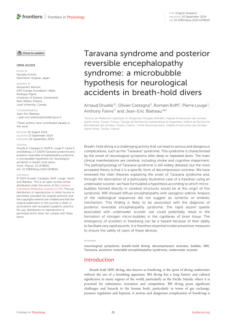


24 - Induction of Cerebral Arterial Gas Embolism in Rat

Authors: Raoul A. Fakkert, Nina C. Weber, Benedikt
Preckel, Robert A. van Hulst, Inge A. Mulder,
Robert P. Weenink
This document describes a method for studying cerebral
arterial gas embolism (CAGE) using rats. Two surgical
techniques were tested: injecting air through the external
carotid artery and direct injection into the common
carotid artery. Both methods were compared, with the
CCA method showing better results in bubble
consistency, embolization time, and fewer complications.
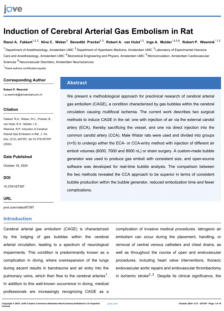

Authors: Pauls Dzelve, Arta Legzdin, Andra Krumina, and
Madara Tirzıte
The Raman effect is a change in scattered light after
photons interact with a molecule. This makes Raman
spectroscopy useful, especially in medicine. It has potential
in pulmonary medicine, analyzing tumors, sputum, and
saliva. Saliva may serve as a quick, inexpensive diagnostic
tool for diseases like COPD, reducing healthcare costs.


25 - Utility of Raman Spectroscopy in Pulmonary Medicine
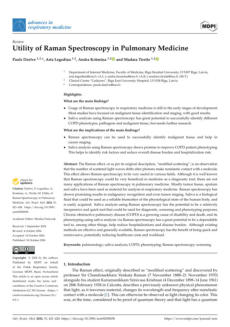



36 - Are Exercise-Induced Premature Ventricular Contractions
Associated with Signifi cant Coronary Artery Disease?
Author: Sok-Sithikun Bun, Clementine Massimelli, Didier
Scarlatti, Fabien Squara and Emile Ferrar
Exercise-induced premature ventricular contractions
(EIPVC) have been linked to higher mortality, but their
connection to coronary artery disease (CAD) is unclear.
This study investigated the relationship between EIPVC
and significant CAD in patients with cardiovascular risk
factors, compared to a control group showing ischemia
during exercise tests. In total, 4098 exercise tests were
done, identifying 46 patients with EIPVC and 71 with
ischemia. CAD was found in 11% of the EIPVC group
compared to 54% in the ischemia group, suggesting
EIPVC is less often associated with CAD.
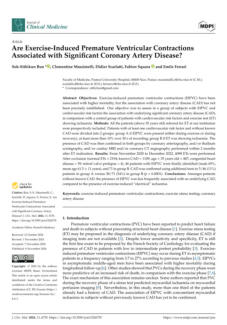



37 - N2 exchanges in hyperbaric environments: toward a model
based on physiological gas transport (O2 and CO2)
Authors: Michael Theron, Alexis Blasselle, Lisa Nedellec,
Pascal Ballet, Emmanuel Dugrenot, Bernard
Gardette, François Guerrero, Anne Henckes,
and Jean-Pierre Pennec
Decompression sickness can happen to divers even when
they follow safe procedures. Individual physiological
conditions can influence bubbling variability, highlighting
the need for personalized input for better decompression.
This study aims to create a new framework for inert gas
exchanges, validating a model for oxygen and transferring
it for nitrogen and carbon dioxide. The new model
demonstrates the integration of various physiological
factors for improved nitrogen saturation and desaturation
models.
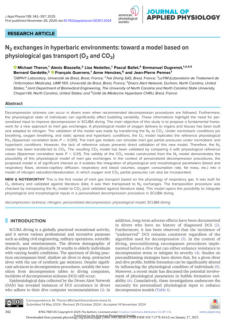



42 - Patent Foramen Ovale (PFO) and Decompression Sickness
Author: Douglas Ebersole
Patent foramen ovale (PFO) is a significant topic in
recreational diving due to its link with decompression
sickness (DCS). DCS occurs in about 2 out of every 10,000
dives, affecting roughly 1,000 divers yearly. PFO may raise
the risk of DCS by 5 to 13 times. Understanding this
connection and treatment options is crucial for divers.
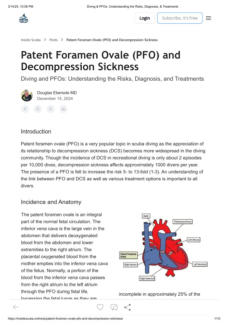



02 - Five sessions of hyperbaric oxygen for critically ill patients with
COVID-19-induced ARDS: A randomised, open label, phase II
trial

Authors:
Anders Kjellberg, Johan Douglas, Michael T. Pawlik, Adrian
Hassler, Sarah Al-Ezerjawi, Emil Bostrom, Lina Abdel-Halim,
Lovisa Liwenborg, Anna-Dora Jonasdottir-Njastad, Jan
Kowalski, Sergiu-Bogdan Catrina, Kenny A. Rodriguez-
Wallberg, Peter Lindholm
Few treatment options are available for COVID-19-
induced acute respiratory distress syndrome (ARDS). A trial
evaluated the benefits and harms of hyperbaric oxygen
treatment (HBOT) for this condition. The study, involving
34 patients, found no significant difference in ICU
admissions between HBOT and control groups. HBOT
showed a favorable safety profile, but no conclusive
benefits were established.
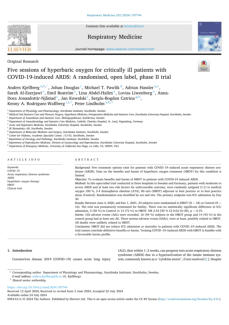



22 - Sex differences in autonomic functions and cognitive
performance during cold-air exposure and cold-water partial
immersion

Author:
Youngsun Kong, Md Billal Hossain, Riley McNaboe, Hugo
F. Posada-Quintero, Matthew Daley, Krystina Diaz, Ki H.
Chon 1 and Jeffrey Bolkhovsky
This study examined how male and female autonomic
functions and cognitive abilities differ during cold-air
exposure and cold-water immersion versus room
temperature air. The study involved 22 males and 19
females who completed cognitive tasks in various
conditions. Results showed that females had slower
reaction times during cold-air exposure, while males
performed similarly or better. Cold-water immersion
impacted men's memory. Both genders had lower
electrodermal activity in cold conditions, and only males
had higher heart rate variability during cold air exposure.
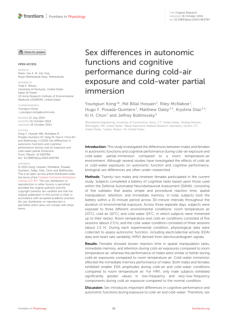


23 - Shock Waves of the Electric Field—Part 2: Experimental Studies
of Vysikayl’s Jumps and Plasma Nozzles in Plasma With Current.
Author: Philipp I. Vysikaylo
This work demonstrates that charged particles in plasma
exhibit self-focusing as a universal characteristic of
cumulative-dissipative structures. This cumulation results
from electric field shock waves and involves complex
interactions of charged particles in gas-discharge plasma.
The article discusses experiments on 3-D structures in
plasma and highlights the importance of electrical
neutrality violations in understanding these phenomena.
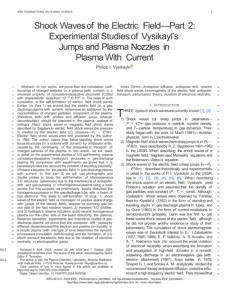



32 - Dynamic Impedance Model of Low-Voltage Electric Shock in
Animals Considering the Influence of Water Electrolysis
Author: Haixin Tong, Xiangjun Zeng, Kun Yu, and Zehua
Zhou
This study addresses time-varying impedance in animals
after low-voltage electric shocks. It introduces a model
considering water electrolysis, showing that internal water
is key to impedance changes. The model improves
prediction accuracy compared to previous methods, with
low error rates.
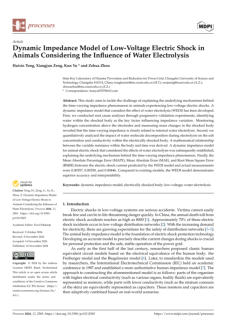



33 - Electrical shock injuries: an analysis of voltage, frequency, and
contact mode determinants
Authors: Suma Gangidi, Mukul Govande, Kyle McCollum,
and Raphael C. Lee
This article reviews medical terms used for diagnosing
electrical shock injuries as technology evolves. It suggests
changes to improve understanding of electrical injuries to
enhance medical care and safety.
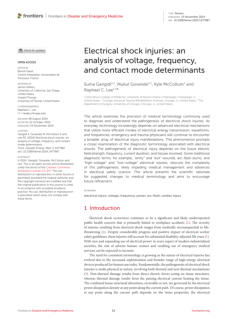



34 - Assessment of Incidents and Immediate Consequences of
Electric Shocks among Nigerians
Authors: Abiodun Ayodeji Ojetoye, Kehinde Monsuru
Adeleke, Samson Ayorinde Akangbe, Matthew
Afolabi Oke, Abimbola Oluwatayo Orisawayi
This study explores how often electric shocks occur in
Nigeria and their effects. A survey and questionnaire
gathered information from victims and witnesses. Many
Nigerians experience electric shocks daily, but many
incidents go unreported. There is also a lack of
understanding about electricity and safety. The study
documents various electric shock cases and suggests
ways to educate the public on safety measures and
prevention strategies to fill this educational gap.
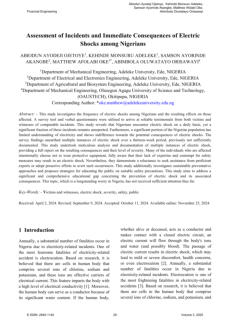



35 - Oral Health Complications of SCUBA Diving
Author: Irena Sionek-Wrega, Jakub Wrega
This review looks at oral health issues related to SCUBA
diving, like barodontalgia, barosinusitis, and TMJ disorders,
as well as dental effects of hyperbaric oxygen therapy. It
involves a literature search for relevant studies and
identifies gaps for future research to improve dental care
for divers. Preventive measures are recommended, and
larger studies are needed for better guidelines.
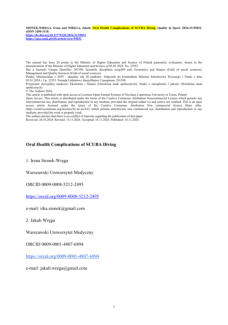

Authors: Cameron M. Suraci, Michael L. Morrison and
Mark B. Roth
This research explores the role of oxygen in the cold shock
death of Caenorhabditis elegans. It found that C. elegans
have increased survival in 2°C when deprived of oxygen,
while an increase to 0.25 kPa of oxygen decreased
survival. Oxygen toxicity produced by a 35-fold increase
above atmospheric oxygen levels was fatal for nematodes
in 8 hours at room temperature and 2 hours at 2°C. Cold
acclimatization and mutations in the cold acclimatization
pathway improved survival in room temperature oxygen
toxicity.
The authors discuss evidence that similar phenomena
may function in humans.


39 - Oxygen is toxic in the cold in C. elegans
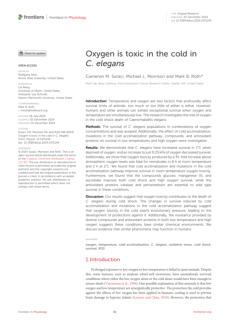



40 - Does Heart Rate Variability Predict Impairment of Operational
Performance in Divers?
Authors: John Freiberger, Bruce Derrick, Ki H. Chon, Md
Billal Hossain, Hugo F. Posada-Quintero, Mary
Cooter, and Richard Moon
The study aimed to validate heart rate variability (HRV) as
a warning sign of cognitive impairment from diving gas
narcosis or oxygen toxicity. The research used NASA's
multi-attribute task battery (MATB-II) flight simulator to
examine the effects of CO2, N2, and O2 partial pressure
on diver performance. Results showed performance
declines were associated with normalized high-frequency
HRV features and the number of pairs of successive R-R
intervals that differed by more than 50 ms. HRV
parameters, including RMSSD, were associated with
performance impairment.
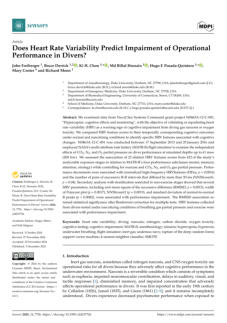


41 - Risk Factors Associated with Middle Ear Barotrauma in Patients
Undergoing Monoplace Hyperbaric Oxygen Therapy.
Authors: Yoon Sung Lee, Sang Won Ko, Hyoung Youn
Lee, Kyung Hoon Sun, Tag Heo, and Sung Min
Lee
The study analyzed data from 296 patients receiving
monoplace hyperbaric oxygen therapy (HBOT) and
found that altered mental state and classification in the
emergency treatment group for HBOT were independent
risk factors for middle ear barotrauma (MEB). These
findings can help develop safer protocols for monoplace
HBOT chamber operations.
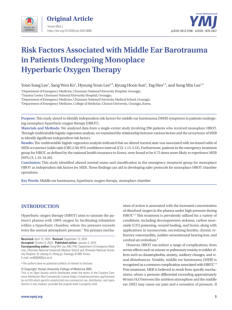


Click on the octopus
to return to the top
of the page

















